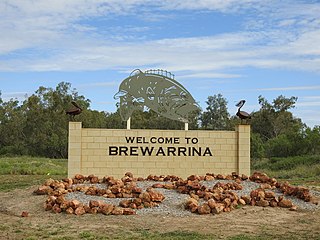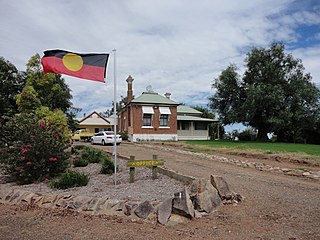
Barwon River, a perennial river that is part of the Murray–Darling basin, is located in the north-west slopes and Orana regions of New South Wales, Australia.

Brewarrina is a town in north-west New South Wales, Australia on the banks of the Barwon River in Brewarrina Shire. The name Brewarrina is derived from 'burru waranha', a Weilwan name for a species of Acacia, Cassia tree, "Acacia clumps", "a native standing" or "place where wild gooseberry grows". It is 96 kilometres (60 mi) east of Bourke and west of Walgett on the Kamilaroi Highway, and 787 km from Sydney. The population of Brewarrina in 2016 was 1,143. Other towns and villages in the Brewarrina district include: Goodooga, Gongolgon, Weilmoringle and Angledool.

Cummeragunja Reserve or Cummeragunja Station, alternatively spelt Coomeroogunja, Coomeragunja, Cumeroogunga and Cummerguja, was a settlement on the New South Wales side of the Murray River, on the Victorian border near Barmah. It was also referred to as Cumeroogunga Mission, although it was not run by missionaries. The people were mostly Yorta Yorta.
An Aboriginal reserve, also called simply reserve, was a government-sanctioned settlement for Aboriginal Australians, created under various state and federal legislation. Along with missions and other institutions, they were used from the 19th century to the 1960s to keep Aboriginal people separate from the white Australian population. The governments passed laws related to such reserves that gave them much power over all aspects of Aboriginal people’s lives.

The Cootamundra Domestic Training Home for Aboriginal Girls, commonly known as "Bimbadeen" and Cootamundra Girls' Home, located at Cootamundra, New South Wales, was a home and training college for Aboriginal girls during the 20th century. It operated by the NSW Government's Aborigines Welfare Board from 1911 to 1968 to provide training to girls forcibly taken from their families under the Aborigines Protection Act 1909. The only training received by the girls was to work as domestic servants, and they were not allowed any contact with their families. They were part of a cohort of Aboriginal people now known as the Stolen Generations.

Deebing Creek Mission is a heritage-listed former Aboriginal reserve at South Deebing Creek Road, Deebing Heights, City of Ipswich, Queensland, Australia. It was built from c. 1887 to c. 1915. It is also known as Deebing Creek Aboriginal Home, Deebing Creek Aboriginal Mission, and Deebing Creek Aboriginal Reserve. It was added to the Queensland Heritage Register on 24 September 2004.

Brewarrina Aboriginal Fish Traps are heritage-listed Australian Aboriginal fish traps on the Barwon River at Brewarrina, in the Orana region of, New South Wales, Australia. They are also known as Baiame's Ngunnhu, Nonah, or Nyemba Fish Traps. The Brewarrina Aboriginal Cultural Museum, opened in 1988, adjoins the site. The fish traps were added to the New South Wales State Heritage Register on 11 August 2000 and to the Australian National Heritage List on 3 June 2005.
The Collarenebri Aboriginal Cemetery is a heritage-listed cemetery and ceremonial site for Indigenous Australians located at Gundabloui Road, Collarenebri, Walgett Shire, New South Wales, Australia. It was built from 1907. The property is owned by Collarenebri Local Aboriginal Land Council. The site was added to the New South Wales State Heritage Register on 19 December 2014.
Burra Bee Dee Mission is a heritage-listed former Indigenous Australian mission, still in use as a cemetery on the Oxley Highway at Coonabarabran in the Orana region of New South Wales, Australia. It was built from 1892 to 1957. It is also known as Forked Mountain. The property is owned by Coonabarabran Local Aboriginal Land Council and the Department of Trade & Investment, Regional Infrastructure & Services. It was added to the New South Wales State Heritage Register on 4 June 2004.

Ulgundahi Island is a heritage-listed Aboriginal site, formerly an occupational settlement, with ongoing usage as farmland and as a site of ongoing significance, at Clarence River by North Arm, Maclean, Clarence Valley Council, New South Wales, Australia. The property is owned by the Yaegl Local Aboriginal Land Council. It was added to the New South Wales State Heritage Register on 24 December 2004.

The Warangesda Aboriginal Mission is a heritage-listed former Australian Aboriginal mission site at Warangesda, Darlington Point, Murrumbidgee Council, New South Wales, Australia. The mission was designed and built between 1880 and 1926. It is also known as Warangesda Aboriginal Mission and Station, Warangesda Mission, Warangesda Aboriginal Station, and Warrangesda. It was added to the New South Wales State Heritage Register on 9 July 2010. The Naden family as well as Florence (Cot) Johnson also lived at Warangesda.

Kinchela Aboriginal Boys' Training Home, also known as Kinchela Boys' Home and the Aboriginal Mission School, is a heritage-listed former Aboriginal Boys' Training Home at 2054 South West Rocks Road, Kinchela, Kempsey Shire, New South Wales, Australia. It was built from 1924 to 1970.

Bomaderry Aboriginal Children's Home is a heritage-listed former Institutional home for Aboriginal children and now Nowra Local Aboriginal Land Council offices at 59 Beinda Street, Bomaderry, in the South Coast region of New South Wales, Australia. It was designed by United Aborigines Mission and built from 1908. It was also known as Bomaderry Children's Home; Bomaderry Babies Home; and United Aborigines Mission Home. The property is owned by Nowra Local Aboriginal Land Council. It was added to the New South Wales State Heritage Register on 17 February 2012.
The La Perouse Mission Church is a heritage-listed former church building and now vacant building and unused church located at 46 Adina Avenue, La Perouse, City of Randwick, New South Wales, Australia. It was built from 1894 to 1930. It is also known as Colebrook Memorial Aboriginal Evangelical Church. The property is owned by La Perouse Local Aboriginal Land Council. It was added to the New South Wales State Heritage Register on 15 March 2013.

The Australian Hall is a heritage-listed community building located at 150–152 Elizabeth Street, in the Sydney central business district, in New South Wales, Australia. It was the site of the Day of Mourning protests by Aboriginal Australians on 26 January 1938. It was also known as the Cyprus–Hellene Club until 1998. The property is owned by the Indigenous Land Corporation, a statutory corporation of the Australian Government. It was added to the Australian National Heritage List on 20 May 2008 and was added to the New South Wales State Heritage Register on 2 April 1999.
Lorna Rose Dixon was an Australian Aboriginal custodian and preserver of the Wangkumara language.
Lake Condah Mission, also known as Condah Mission, was established in 1867 as a Church of England mission in Victoria, Australia. It is approximately 3 kilometres (1.9 mi) from Lake Condah—traditionally known as Tae Rak—and about 20–25 kilometres (12–16 mi) south-east of Condah. The site of the mission, on 2,000 acres (810 ha) north of Darlot Creek, was formally reserved in 1869, and the Mission continued operations until the reserve was finally revoked in 1951, with most of the land handed over to the Soldiers Settlement Scheme to provide land for white veterans of World War II.
The New South Wales Aborigines Protection Association, also known as NSW Aborigines Protection Association, Association for the Protection of Aborigines, Aborigines Protection Association and Aboriginal Protection Association, was a private body which supported Aboriginal Australians in New South Wales, Australia. Specifically, it administered Maloga Mission until the residents moved to Cumeroogunga, and the mission stations at Warangesda and Brewarrina.
Sackville Reach Aboriginal Reserve was located on the Hawkesbury River near Windsor in New South Wales, established in 1889 by the NSW Aborigines Protection Board. The government of the colony of New South Wales gazetted and revoked land for this community in the Parish of Meehan, County of Cook gazetting AR 23,957, AR 23,958 and AR 28,546.















